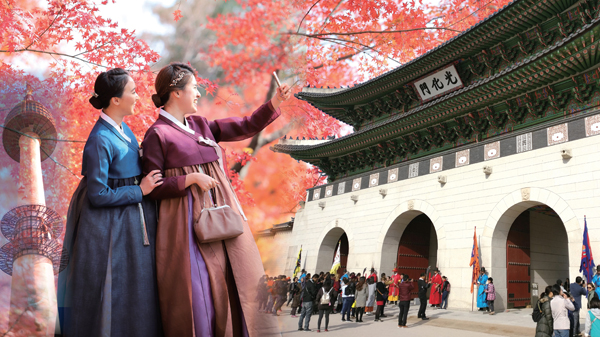
Seoul Searching: Exploring the countless sights of South Korea’s capital city
Despite boasting a population of just over 50 million souls, the nation of South Korea has in the past four decades, become something of a cultural powerhouse, with its music, electronics, cuisine, cosmetics and TV shows entering the mainstream and developing a legion of fans across the globe. Indeed, it’s no stretch to say the world is now obsessed with South Korea. This, in turn, has turned its capital of Seoul into one of Asia’s most visited destinations, drawing over 17.5 million intrepid travellers in 2019.

Sadly, the coronavirus pandemic has brought all travel to a sudden halt, but that doesn’t mean you can’t plan ahead to better days when borders once again open up and you can visit this unique destination once more. In preparation, we highlight some of Seoul’s most visit-worthy sights to put on your itinerary…

Gyeongbokgung
Perhaps the most iconic of Seoul’s five palaces, Gyeongbokgung is also the largest. Built in 1395 during the Joseon Dynasty as its main royal residence, it was destroyed during World War II by Japanese occupiers, but the Korean government has painstakingly rebuilt and restored the complex – which encompasses some 330 buildings in all – back to its original glory. Visitors here should not miss the changing of the guard ceremony, which occurs at 10am and 2pm daily. For a truly culturally immersive experience, you can also explore the National Palace Museum and National Folk Museum that are on the grounds. The entrance fee is even waived for guests dressed in the traditional hanbok robes, which can be rented at various outlets in the city.
Changdeokgung
A short walk to the east of Gwanghwamun – the main gate of Gyeongbokgung – is Changdeokgung, the city’s second-largest palace. Dotted with a plethora of leafy pathways, ancient temples and picturesque pavilions, it affords travellers a tranquil reprieve from the urban jungle just beyond its boundaries. Changdeokgung is a particularly popular hotspot for tourists and Seoulites alike during the spring and autumn seasons, with cherry blossoms blooming during the former and spectacular fall foliage on display during the latter.
Bukchon Hanok Village
Nestled between the two palaces atop the hill, you will find the traditional Korean village, also known as a hanok, of Bukchon. Once inhabited by nobility and high-ranking government officials, in all, some 400 old-fashioned houses comprise the mini-town. Many have since been transformed into cultural centres, guest houses, tea houses, shops and eateries. Perhaps among the city’s most Instagrammable locales, it’s not unusual to see its rustic streets thronged by crowds dressed in hanbok couture.
Cheonggyecheon Stream
Amid the skyrise-laden buildings of Seoul’s business district runs a 10km-long stream lined with pedestrian promenades – Cheonggyecheon Stream. Popular throughout the year as a getaway from the hustle and bustle of city life, it’s a particular draw during such holidays as Buddha’s Birthday, the Lantern Festival and Christmas, when the waterways are punctuated with various artworks and illuminations. As you meander along the river, keep an eye out for sign posts for Gwangjang Market, the city’s oldest traditional market. Laden with everything from kitchen appliances to dummy food props, the key highlights here are the array of culinary treats on offer at its centre. Here, must-try dishes include mandu (Korean dumpling) soup, bibimbap – rice topped with various vegetables and meats and presented in a hot stone pot – and, of course, the famous Korean mung bean pancake, or bindaetteok, a deep-fried concoction fronted by such ingredients such as mung beans, bean sprouts, onions, peppers and egg.
Namdaemun Market
Another must-visit destination for foodies is Namdaemun Market, the largest traditional market in the country. Frequented by locals and tourists alike, you’ll find everything from fresh produce to clothing in the many stalls on display. Alongside these are a veritable treasure trove of cheap eats, ranging from spicy tteokbokki rice cakes and meat skewers to kimchi stews and seafood. Retailers here open through the day, while wholesalers and food vendors work through the night from 11pm to 4am. The best way to cover most ground here is to graze sparingly, taking small portions as you walk through the market in order to save some appetite for other culinary treats you may discover.
N Seoul Tower
For a change of scenery, perhaps a visit to N Seoul Tower – perched atop the 243m Namsan Mountain – is the way to go. Adventurous and athletically inclined explorers can actually scale to the peak via a 2km trail, while those in search of a more sedentary option can head to the cable car instead. The tower measures some 236m in height, and the observatory platform there affords some of the city’s best panoramas. To prolong your visit, drop by the revolving restaurant, and for couples in love, don’t forget to add your own ‘lock of love’ to lock-laden gates here.
Gangnam
Heading back into town, no visit to Seoul is complete without visiting the bustling neighbourhood of Gangnam. Made famous with singer Psy’s viral 2012 hit, Gangnam Style, it’s brimming with trendy restaurants, upscale cocktail bars and much more. The area is also home to the COEX Mall, the world’s largest underground shopping complex, where you’ll find hundreds of stores, a mammoth book store, a Megabox movie theatre and even the COEX Aquarium. Fans of K-pop should also head to SM Town, a museum dedicated to the country’s modern musical culture. Here, you can even watch full hologram renditions of past concerts – a wonderfully quirky way to experience the modern side of South Korea.













